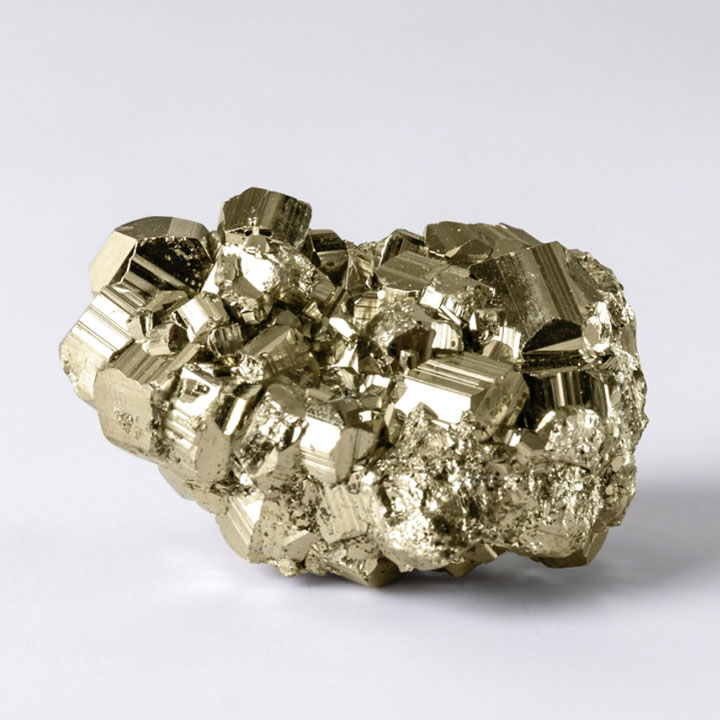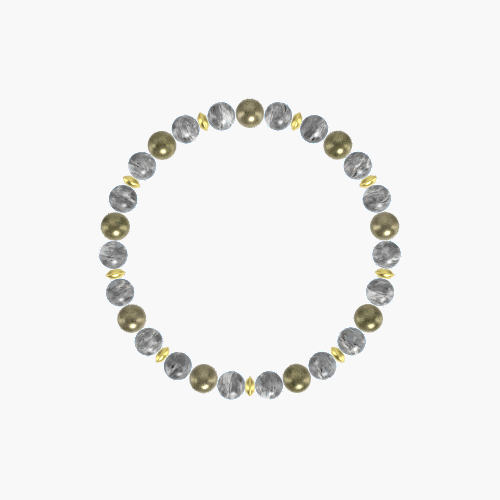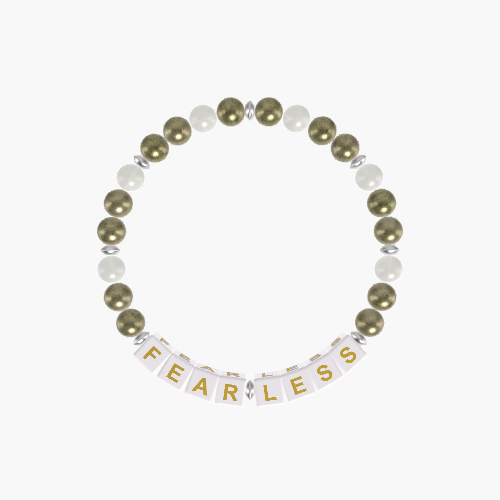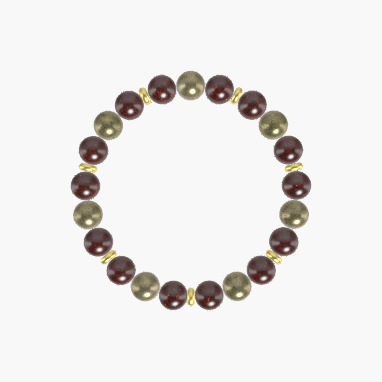Pyrite
Optimism Protection Luck Confidence Creativity
About Pyrite
Pyrite, often dubbed "Fool's Gold" for its deceptive shimmer akin to real gold, captivates with its metallic luster and golden hue. This mineral is not only a symbol of wealth and good luck but also embodies protection and intellect. Its striking appearance and historical significance make it a fascinating subject in both gemology and folklore.
Physical and Geological Properties
Pyrite is an iron sulfide mineral characterized by its cubic, or octahedral crystal form and a Mohs hardness of 6 to 6.5, indicating a relatively high level of hardness that makes it suitable for various jewelry applications. Its distinctive metallic luster and pale brass-yellow hue give it a resemblance to gold, hence its nickname. Pyrite forms in a variety of geological environments, including sedimentary, metamorphic, and igneous rocks. Significant deposits can be found in Italy, Spain, Kazakhstan, the United States, and Peru. Its presence is often associated with other valuable minerals such as quartz and lapis lazuli, enhancing its appeal in gem and mineral collections.
Historical Background
The name "Pyrite" originates from the Greek word 'pyr' meaning "fire," as it can create sparks when struck against metal or stone, a property that made it useful in early fire-starting techniques. Throughout history, Pyrite has been mistaken for gold, leading to its nickname "Fool's Gold." However, this resemblance has also bestowed upon it a symbolic value of wealth and abundance. In ancient and medieval times, Pyrite was used as a decorative element due to its reflective properties and was even ground into powder for use in traditional medicines and ink manufacturing.
Metaphysical Properties and Symbolic Meanings
Metaphysically, Pyrite is considered a stone of protection, intellect, and memory enhancement. It is believed to shield the wearer from negative energy and environmental pollutants. Pyrite also promotes physical well-being by strengthening the wearer's willpower and confidence. It is associated with the solar plexus chakra, enhancing vitality and personal power. Although not a traditional birthstone, Pyrite holds particular appeal for those looking to attract wealth, success, and positive energy into their lives.
Pairing with Other Gemstones
Pyrite pairs well with other stones that amplify its protective and energizing qualities. Black Tourmaline, known for its grounding and protective properties, complements Pyrite's energy shield against negativity. Clear Quartz can enhance Pyrite's clarity of intellect, while Citrine's association with prosperity and abundance magnifies the financial aspects of Pyrite's symbolism. These combinations make for powerful and visually striking jewelry pieces that harness both the aesthetic and metaphysical qualities of the stones.
Basic Care Instructions
Pyrite requires careful handling to maintain its striking appearance. It should be kept dry, as exposure to humidity and water can cause it to tarnish or even form sulfuric acid. Clean Pyrite with a dry cloth to remove dust and store it in a dry, cool place. Avoid using harsh chemicals or ultrasonic cleaners. Given its susceptibility to oxidation, Pyrite jewelry should be worn and stored with care to preserve its golden luster.
Use in Bracelets
Pyrite is a compelling choice for bracelets, offering both aesthetic appeal and metaphysical benefits. Its gold-like appearance adds a touch of luxury and sophistication, making it suitable for both casual and formal wear. A Pyrite bracelet can serve as a daily reminder of the wearer's strength, protectiveness, and potential for attracting abundance. Furthermore, when combined with other gemstones, Pyrite bracelets can offer a synergistic blend of energies, tailored to the wearer's intentions. Its durability and unique beauty make Pyrite an intriguing and meaningful addition to any jewelry collection.








